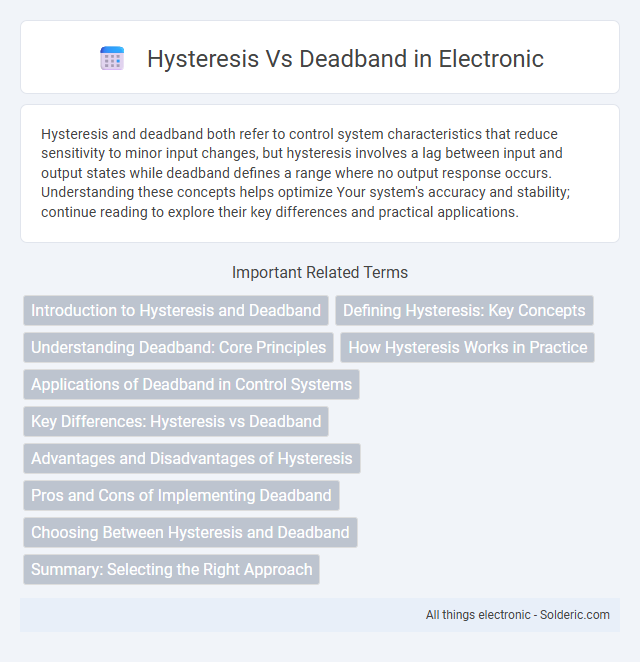Hysteresis and deadband both refer to control system characteristics that reduce sensitivity to minor input changes, but hysteresis involves a lag between input and output states while deadband defines a range where no output response occurs. Understanding these concepts helps optimize Your system's accuracy and stability; continue reading to explore their key differences and practical applications.
Comparison Table
| Feature | Hysteresis | Deadband |
|---|---|---|
| Definition | Difference between activation and deactivation thresholds to prevent rapid switching. | Range where no output change occurs despite input variations. |
| Purpose | Avoids oscillation by creating two distinct switching points. | Reduces sensitivity to small signal changes within a neutral zone. |
| Typical Use | Switches, relays, thermostats. | Control systems, sensors, amplifiers. |
| Behavior | System switches ON at one threshold and OFF at another. | System remains stable without output change inside deadband range. |
| Effect on Signal | Introduces lag to prevent rapid toggling. | Ignores small input fluctuations to prevent noise response. |
| Implementation | Two thresholds defining upper and lower limits. | Flat response zone around the setpoint. |
Introduction to Hysteresis and Deadband
Hysteresis and deadband are critical concepts in control systems to prevent unnecessary oscillations and improve stability. Hysteresis refers to the phenomenon where the output depends on both the current input and the history of past inputs, creating a lag effect. Deadband is a specified range around a setpoint where no output change occurs, effectively filtering minor fluctuations and noise from triggering responses.
Defining Hysteresis: Key Concepts
Hysteresis refers to the dependence of a system's output on both its current input and its past inputs, resulting in a lag or delay effect that prevents frequent switching near threshold points. This characteristic is crucial in control systems to maintain stability by creating a buffer zone where changes in input do not immediately alter the output, effectively reducing noise and oscillations. Unlike deadband, which defines a fixed range of input with no output response, hysteresis involves a directional dependency and memory effect in system behavior.
Understanding Deadband: Core Principles
Deadband refers to a specific range of input values where no output response occurs, effectively preventing unnecessary system activations and reducing noise sensitivity. Unlike hysteresis, which relies on different thresholds for switching states to avoid rapid oscillations, deadband creates a neutral zone that stabilizes system performance by ignoring minor fluctuations. Understanding deadband helps you optimize control systems for precision and efficiency by minimizing false triggers and enhancing signal clarity.
How Hysteresis Works in Practice
Hysteresis operates by creating a controlled delay between the input signal and output response, preventing rapid switching and enhancing system stability in devices like thermostats and sensors. This means your system only changes state when the input crosses predefined thresholds that differ for switching on and off, reducing noise-induced oscillations. In contrast, deadband defines a range where no output change occurs despite input variations, whereas hysteresis ensures smoother transitions by considering both current and past input values.
Applications of Deadband in Control Systems
Deadband in control systems is widely used to prevent continuous oscillations by defining a range where no action is taken despite input changes, enhancing system stability and reducing wear on mechanical components. Applications include thermostats, where deadband avoids frequent on-off cycling, and motor controls, where it prevents hunting by ignoring minor deviations around a setpoint. This strategy improves energy efficiency and prolongs equipment lifespan by minimizing unnecessary adjustments.
Key Differences: Hysteresis vs Deadband
Hysteresis refers to the lag between input and output response in a system, causing different thresholds for activation and deactivation, while deadband defines a range of input values within which there is no output change. The key difference lies in hysteresis producing a looped input-output characteristic with memory effects, whereas deadband creates a neutral zone that prevents small fluctuations from triggering output changes. Systems with hysteresis are often used for stability and noise reduction, while deadband is commonly implemented to avoid unnecessary system activations around a setpoint.
Advantages and Disadvantages of Hysteresis
Hysteresis provides advantages such as improved system stability by preventing rapid switching and noise sensitivity in control applications, which reduces wear on mechanical components and enhances signal clarity. However, it can introduce a delay in response and reduced precision in maintaining exact setpoints, potentially causing less accurate control in sensitive systems. The choice between hysteresis and deadband depends on the specific application requirements for responsiveness versus stability.
Pros and Cons of Implementing Deadband
Implementing a deadband reduces system sensitivity to small input fluctuations, minimizing noise and preventing excessive actuator wear in control systems. However, it can introduce a delay in response and reduce precision, potentially causing less accurate control in applications requiring tight regulation. Deadband is beneficial for systems where stability and reduced actuator activity outweigh the need for immediate response.
Choosing Between Hysteresis and Deadband
Choosing between hysteresis and deadband depends on the specific application requirements for precision and noise tolerance. Hysteresis provides stability by preventing frequent switching in systems like thermostats or relay controls, reducing wear and improving response reliability. Deadband, often used in control systems and sensors, creates a neutral zone to eliminate minor fluctuations but may sacrifice some accuracy for smoother operation.
Summary: Selecting the Right Approach
Hysteresis provides a controlled response by introducing a buffer zone that prevents rapid switching in feedback systems, ideal for reducing noise in sensors and thermostats. Deadband eliminates action within a defined range, making it effective for mechanical systems requiring stability without constant adjustments. Choosing between hysteresis and deadband depends on the application's sensitivity to fluctuations and the desired balance between responsiveness and stability.
hysteresis vs deadband Infographic

 solderic.com
solderic.com